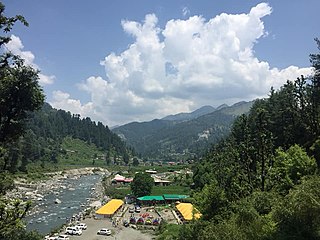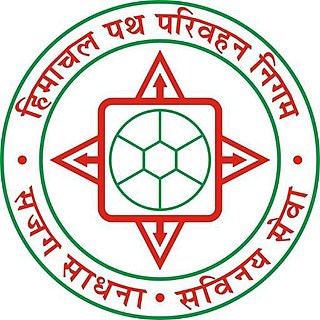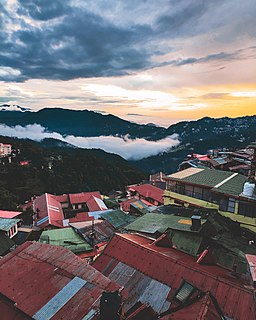
Vijayadashami, also known as Dussehra, Dasara or Dashain, is a major Hindu festival celebrated at the end of Navaratri every year in the Indian subcontinent. It is observed on the tenth day in the Hindu calendar month of Ashvin, the seventh month of the Hindu Luni-Solar Calendar, which typically falls in the Gregorian months of September and October.
Kullu is a district in Himachal Pradesh, India. It borders Rampur district to the south, Mandi and Kangra districts to the west, and the Lahaul and Spiti district to the north and east. The largest valley in this mountainous district is the Kullu Valley. The Kullu valley follows the course of the Beas River, and ranges from an elevation of 833m above sea level at Aut to 3330m above sea level at the Atal Tunnel South Portal, below the Rohtang Pass. The town of Kullu, or simply Kullu, located on the right side of the Beas River, serves as the administrative headquarters of the Kullu district. The Kullu district also incorporates several riverine tributary valleys of the Beas, including those of the Parvati, Sainj, and Tirthan rivers, and thus some regions somewhat distant from the Kullu valley. The economy of the district relies mainly on horticulture, agriculture, tourism, and traditional handicrafts.

Kullu is a municipal council town that serves as the administrative headquarters of the Kullu district of the Indian state of Himachal Pradesh. It is located on the banks of the Beas River in the Kullu Valley about 10 kilometres (6.2 mi) north of the airport at Bhuntar.

Hidimba was a powerful demon king who is mentioned in the epic Mahābhārata. He was killed by Bhima and this is recounted in the 9th sub-parva of the Adi Parva.

Palampur is a hill station and a municipal corporation situated in the Kangra District in the Indian state of Himachal Pradesh. It is surrounded by pine forests and flanked by the Dhauladhar ranges. There are numerous streams flowing from the mountains to the plains, from Palampur. The combination of greenery, snowclad mountains and water gives Palampur a distinctive look.

Malana is an ancient Indian village in the state of Himachal Pradesh. This solitary village in the Malana Nala, a side valley of the Parvati Valley to the north-east of Kullu Valley, is isolated from the rest of the world. The peaks of Chanderkhani and Deo Tibba shadow the village. It is situated on a remote plateau by the side of the torrential Malana river, at a height of 2,652 metres (8,701 ft) above sea level. Malana has its own lifestyle and social structure and people are strict in following their customs. Malana has been the subject of various documentaries, including Malana: Globalization of a Himalayan Village, and Malana, A Lost Identity. The existing speakers of the autochthonous language Kanashi, the traditional language of the inhabitants of Malana, number approximately 1700. According to the 1961 census, the language speakers were then 563, but today the population of Malana is at least three times as large as 40 years ago. The most common route to the village is by taxi or bus from Jhari. One stop prior to Malana. Roads till Malana Village trekking gate are developed.
The North Indian state of Himachal Pradesh is a state that has remained largely uninfluenced by Western culture. Himachal Pradesh is a multi-religion practising, multicultural and multilingual state. Some of the most commonly spoken languages are Hindi and the various Pahari languages. The Hindu communities residing in Himachal include the Brahmins, Rajputs, Kannets, Rathis and Kolis. There are also tribal population in the state which mainly comprise Gaddis, Kinnarms, Gujjars, Pangawals and Lahaulis.
The Katyuri kings were a medieval Hindu Rajput's ruling clan of Khasha origin from Joshimath that ruled over the regions in present day regions of Kumaon, Uttarakhand in India and parts of Doti/Sudurpashchim Province in Nepal from 700 to 1200 CE. The founder of this dynasty, King Vasu Dev was originally a Buddhist ruler, but later he started following Hindu practices sometimes attributed to a vigorous campaign of Hindu philosopher Adi Shankara.

Barot, a village originally developed in 1920s for Shanan Hydel Project, is now a tourist location in Mandi district in the Indian state of Himachal Pradesh. Barot was difficult to access until 1975, when a road was opened. It is situated 40 km from Jogindernagar and 65 km from Mandi, the District Headquarter. The road to Barot branches off at Jogindernagar-Mandi Highway and from Jogindernagar the distance is 40 km. It is sometimes possible to use the funicular trolley from Jogindernagar which reduces the distance to 12 km. The road route includes terraced fields and thick cedar forests, rising to Jhatingri at the hilltop. The remains of the summer palace of the former rulers of Mandi are located here. Through the little village of Tikkan, the road carries on to Barot. The town has a range of outdoor activities, including a trout breeding centre, from where fish are released into the Uhl river. A 30 km section of the river is used for angling.

Nargu Wildlife Sanctuary lies on the east side of the Uhl River in Mandi District of Himachal Pradesh. It was notified in 1999 and covers an area of 132.37 km2 (51.11 sq mi). The slopes of the sanctuary are covered with Alpine forest. It is home to various species of animals and birds.

Mahasu Devta Temple, is located on the Tuini-Mori road at Hanol, Dehradun district, Uttarakhand,India. The temple is dedicated to Mahasu Devta. Lord Mahasu is the chief deity of this area and is worshipped in Mahasu Devta Temple by the people of Hanol and nearby villages of Uttarakhand and Himachal Pradesh state of India. It is the ancient temple of Mahasu Devta built in the 9th century. The temple was constructed in Kath-Kuni or Koti-Banal style of architecture. It is included in the Archaeological Survey of India list of the ancient temple in the Dehradun circle, Uttarakhand.

Mandi Shivaratri Fair is an annual renowned international fair that is held for 7 days starting with the Hindu festival of Shivaratri, in the Mandi town of the Indian state of Himachal Pradesh.

Mandi is a major city and a municipal corporation in Mandi District in the Indian state of Himachal Pradesh.
Salooni is the tehsil headquarter and Sub-Division in Chamba district of Himachal Pradesh, India. Salooni is an important regional administrative and economic centre. It has a mini secretariat, SDM office, government senior secondary school, Degree College, community health centre and many other sub-division level important government offices. Salooni falls under Dalhousie legislative constituency. The entrance to the small township has a series of few quaint shops, followed by small ground with an ancient goddess Kali temple at other end.

Ramman is a religious festival and ritual theatre of the Garhwal region in India. It is a festival of the Garhwali People in the Saloor Dungra village of the Painkhanda Valley in the Chamoli district in Uttarakhand, India.

Karsog is a town and municipal area in the state of Himachal Pradesh in Northern India.

Himachal Road Transport Corporation, also referred to as HRTC, is the state-owned road transport corporation of the state of Himachal Pradesh, India. HRTC provides bus services to towns and cities within Himachal Pradesh and the adjoining and nearby states of Uttarakhand, Punjab, Haryana, Delhi, Uttar Pradesh, Jammu and Kashmir and Rajasthan. HRTC is one of the first RTC's in India to offer a facility for online booking of tickets for all types of buses.

Tourism in Himachal Pradesh relates to tourism in the Indian state of Himachal Pradesh. This is popularly renowned for its Himalayan landscapes and popular hill-stations. Many outdoor activities such as rock climbing, mountain biking, paragliding, ice-skating, trekking, rafting, and heli-skiing are popular tourist attractions in Himachal Pradesh.

Bhalara is a village in Himachal Pradesh, India. It is located in the Rohru block of the Shimla district, and is situated 15 km from the town of Rohru.
Sharog is a village in Shimla district in the Indian state of Himachal Pradesh. It is a located near the town of Rohru and is about 125 kilometres (78 mi) away from Shimla and 8 km from Rohru. There is a temple of Devi Jaga Mata and the people of this village worship Dhonlu Devta, Shalonu Devta and Mahasu Maharaj. There is a temple of Dhonlu Devta.














